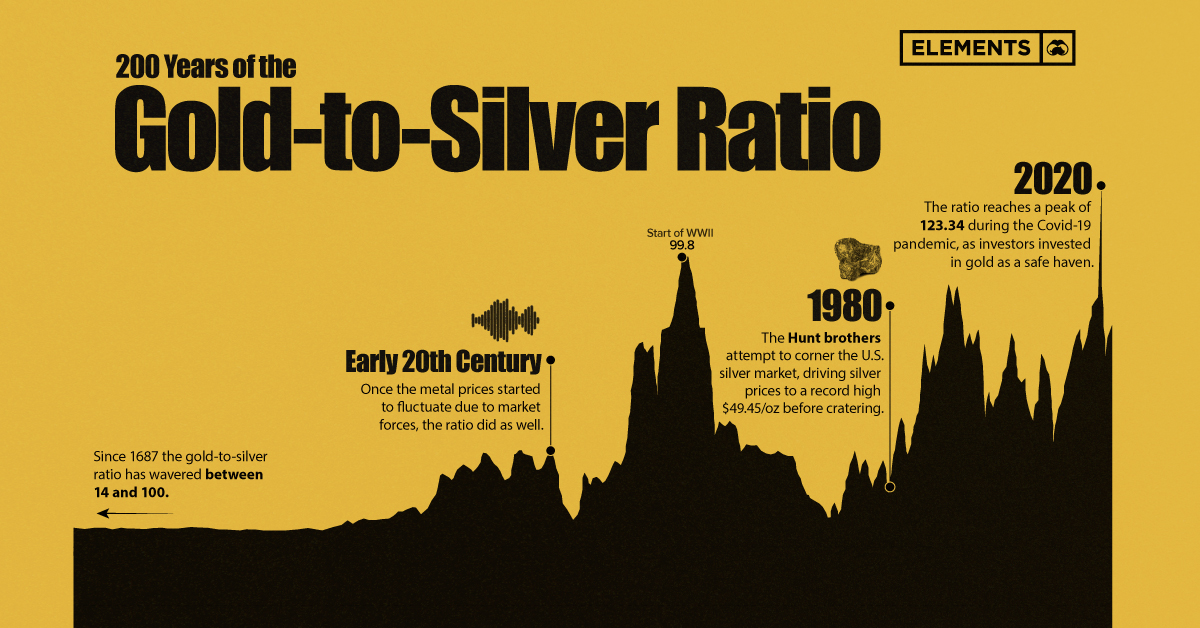Mapped: U.S. Non-fuel Mineral Production, by State
Just how many minerals does the U.S. consume? In 2020, non-fuel mineral consumption worked out to around 19,000 pounds or 8.6 tonnes per person.
This includes metals like copper, iron ore, and zinc, along with construction sand, stone, cement, and other industrial minerals. With such high demand, changes in the production of these commodities often reflect how the overall economy is performing.
The above infographic maps U.S. non-fuel mineral production by state in 2021 using data from the United States Geological Survey (USGS).
The Most Valuable Minerals
As the U.S. economy restarted in 2021, American mines generated over $90 billion in non-fuel mineral production, a 12% increase from 2020.
Before diving into the breakdown by state, here’s a look at production value by mineral type:
| Category | Production value | % of Total |
|---|---|---|
| Metals | $33.8B | 37.4% |
| Construction aggregates | $29.2B | 32.3% |
| Industrial minerals (excl. construction) | $27.4B | 30.3% |
| Total | $90.4B | 100% |
Each of the categories accounted for roughly one-third of the total production value, with metals making up the largest share. Within metals, copper and gold collectively accounted for 66% of the total, followed by iron ore (13%) and zinc (7%).
The production of sand, gravel, and crushed stone—important inputs for construction—also made up a significant chunk of the value, along with other industrial minerals. Furthermore, crushed stone was the leading non-fuel mineral in 2021, with $19.3 billion in production value.
Which States Lead in Mineral Production?
Arizona, Nevada, Texas, California, and Minnesota—the top five states—accounted for nearly 40% of non-fuel mineral production value.
| State | Value of Non-fuel Mineral Production | % of Total |
|---|---|---|
| Arizona | $10B | 11.0% |
| Nevada | $9.4B | 10.3% |
| Texas | $5.8B | 6.4% |
| California | $5.3B | 5.8% |
| Minnesota | $4.0B | 4.4% |
| Alaska | $3.9B | 4.3% |
| Utah | $3.8B | 4.1% |
| Missouri | $3.3B | 3.7% |
| Michigan | $3.0B | 3.3% |
| Wyoming | $2.8B | 3.0% |
| Florida | $2.4B | 2.7% |
| Georgia | $2.0B | 2.3% |
| Montana | $2.0B | 2.2% |
| Pennsylvania | $2.0B | 2.2% |
| Alabama | $1.9B | 2.1% |
| Colorado | $1.6B | 1.8% |
| New York | $1.6B | 1.7% |
| Tennessee | $1.6B | 1.7% |
| Virginia | $1.6B | 1.7% |
| North Caroline | $1.5B | 1.6% |
| Ohio | $1.4B | 1.5% |
| New Mexico | $1.3B | 1.4% |
| Kansas | $1.2B | 1.3% |
| Indiana | $1.2B | 1.3% |
| Arkansas | $1.0B | 1.1% |
| Wisconsin | $1.0B | 1.1% |
| Illinois | $1.0B | 1.1% |
| Iowa | $0.96B | 1.1% |
| South Carolina | $0.95B | 1.1% |
| Oklahoma | $0.92B | 1.0% |
| Washington | $0.73B | 0.8% |
| Idaho | $0.72B | 0.8% |
| Louisiana | $0.66B | 0.7% |
| Oregon | $0.60B | 0.7% |
| Kentucky | $0.59B | 0.6% |
| South Dakota | $0.50B | 0.5% |
| Maryland | $0.46B | 0.5% |
| New Jersey | $0.40B | 0.4% |
| West Virginia | $0.36B | 0.4% |
| Nebraska | $0.22B | 0.2% |
| Massachusetts | $0.21B | 0.2% |
| Mississippi | $0.20B | 0.2% |
| Connecticut | $0.18B | 0.2% |
| Hawaii | $0.13B | 0.1% |
| Maine | $0.13B | 0.1% |
| Vermont | $0.11B | 0.1% |
| New Hampshire | $0.095B | 0.1% |
| Rhode Island | $0.066B | 0.07% |
| North Dakota | $0.065B | 0.07% |
| Delaware | $0.022B | 0.02% |
| Undistributed | 4.0B | 4.5% |
| Total | $90.4B | 100.0% |
Arizona and Nevada, the top two states, are the country’s biggest producers of copper and gold, respectively. Arizona also produced over $1 billion worth of construction sand and gravel in 2021, in addition to being the country’s leading producer of gemstones.
In third place was Texas, where mines produced nearly $6 billion worth of non-fuel minerals, of which 38% came from crushed stone. California, meanwhile, led in the production of construction sand and gravel, and was the country’s sole source of rare earth elements.
Minnesota also made the top five as the nation’s largest producer of iron ore. In fact, mines in Minnesota and Michigan shipped 98% of domestic usable iron ore products in 2021.
The Missing Critical Minerals
Although the U.S. is a major producer of non-fuel minerals, it still relies on imports for the supply of several minerals.
In 2021, the U.S. imported $5.3 billion worth of raw materials, in addition to $90 billion in net imports of processed mineral materials. Of the 50 minerals deemed critical to national security, the country was 100% net import reliant for 26, including graphite, manganese, and several rare earth metals.
To meet the rising demand for these minerals, U.S. President Biden announced major investments in domestic critical mineral production, including a $35 million grant to MP Materials for the processing of rare earths.
It remains to be seen whether these investments will pay off in building more resilient, end-to-end domestic critical mineral supply chains.
